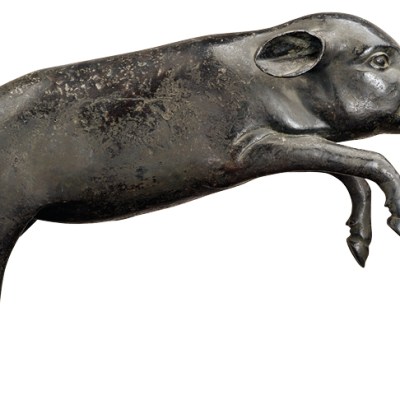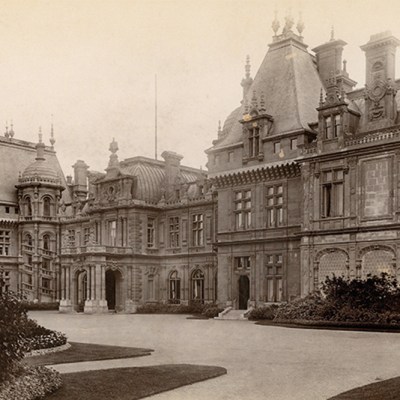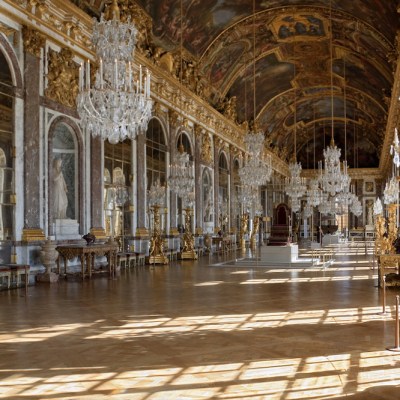From the May 2022 issue of Apollo. Preview and subscribe here.
You approach Wentworth Woodhouse, near Rotherham in South Yorkshire, from its southern flank, which exaggerates the effect of its 600-foot facade, at twice the width of Buckingham Palace the longest of any house in Britain. The austere Palladian design, with a portico of enormous Corinthian columns, is a massive piece of architectural theatre, signalling power and the total domination of the land.
Until five years ago, Wentworth Woodhouse was not open to the public and as a result is not as well-known as Chatsworth, Blenheim or Stowe. In 2016, it was acquired by the Wentworth Woodhouse Preservation Trust for £7m, which reflected the large cost of repairs. A grant of £7.6m from the Treasury paid for urgent remedial work, and 2.5 acres of roof has been made watertight. A new gas boiler has also been installed, which will help the house to dry out, and an entrepreneurial masterplan developed to open and regenerate the building in manageable and financially sustainable phases over the next 20 years.
Wentworth Woodhouse is actually two houses, placed back to back in a style typical of the north of England, built by Thomas Watson-Wentworth, later the first Marquess of Rockingham. The first house, facing west, is a baroque brick mansion, begun in 1724, which looks out on to a secret garden screened by trees. However, even before it was finished, the larger Palladian building, modelled on Wanstead House in Essex, was commissioned facing east. Designed by Henry Flitcroft, a disciple of Lord Burlington, it literally turns its back on the baroque and was thought to better represent the family’s emphatically Whig tastes.
Wentworth Woodhouse, inherited by the Earls Fitzwilliam, has five miles of corridor and a room for every day of the year; it is so vast that on arrival guests used to be presented with a crested silver casket full of different-coloured confetti so that, when called for dinner, they could leave a Hansel-and-Gretel-like trail back to their room. The house’s great fortune was based on coal, and the discovery in the late 18th century that the 19,000-acre estate straddled the rich Barnsley seam. It was to become a powerhouse of the Industrial Revolution and the surrounding countryside was once covered in headstocks, pulley-wheels, chimneys and slag heaps. In 1912, George V stayed at Wentworth Woodhouse on his tour of the north, planned in response to industrial unrest, when he descended one of the Earl’s mines. The day after he did so, explosions in another of the Fitzwilliams’ collieries killed 88 men.
In Black Diamonds (2007), Catherine Bailey chronicles the decline and fall of the Earls Fitzwilliam in the 20th century. The title was subject to fierce feuds about illegitimacy, changelings, gold diggers and mental deficiency, as the family fought for control of a massive fortune with near feudal obligations. Bailey shows how aristocratic privilege was unravelling as a result of world wars and the threat of revolution.
The Marble Saloon. Photo: Scott Bairstow / Alamy Stock Photo

You enter Wentworth Woodhouse through the Pillared Hall, where footman liveried in yellow and black would once have greeted you, before ascending a split staircase, watched over by a statue of the goddess Ceres, supposedly from Herculaneum, to a grand Marble Saloon. This vast hall has been described as one of the finest Georgian interiors in the country. Nevertheless, paint is peeling off the ceiling to reveal timbers scarred by dry rot, emblematic of the challenges faced by the Trust. Most of the surrounding state rooms, with their ornate stucco work and gilding, are empty, the paintings by Titian, Van Dyck, Guido Reni, Raphael and Reynolds long gone, their extravagantly plastered ceilings and hand-painted wallpapers marked by similar evidence of neglect and damp.
The House was requisitioned during the Second World War by the Intelligence Corps, which in hindsight marked its demise as a great house. Possessions were removed to cellars, marble floors boarded over, and the family retreated to the older part of the house in the west wing, never to return. Immediately after the war, using emergency powers, the new Labour government ordered that the parkland surrounding the house be exploited for coal, a decision that was contentious even with the coal miners’ association, whose members had long been granted free access to the grounds.
The eighth Earl – affectionately called ‘king dandy and scum’ by Evelyn Waugh – saw this as class warfare. Trees were felled and the Humphry Repton-designed landscape was dug up for opencast mines, creating a lunar landscape that came to within 16 feet of his door. Black coal dust still tarnishes the pillars and stonework of the house. In 1947 the coalfields were nationalised, which robbed Wentworth Woodhouse of its source of wealth. The Ministry of Health proposed that the mansion house ‘homeless industrial families’ and, to prevent this, the Earl offered it to the National Trust, which felt that it could not afford to take it on.
In 1948, at the age of 37, the Earl died in a plane crash along with ‘Kick’ Kennedy (sister to JFK), with whom he was having an affair. That year, Sotheby’s hosted one of the first of the great country house auctions at Wentworth, with lot after lot going under the hammer in a five-day sale. In 1949, the house became the Lady Mabel College of Physical Education. The grand marble hall was used as a gymnasium, the Whistlejacket Room, named after George Stubbs’s painting of the Second Marquess’s rearing Arabian steed that now hangs in the National Gallery, as a dance studio. In 1989 the family separated the house from the wider estate, and Britain’s largest private home was sold on the open market. However, it proved too much of a money pit for any individual to maintain.
Many of the cavernous, empty state rooms now have reproductions on easels of photographs taken in 1934 for Country Life, which show the sumptuously furnished interiors in their former glory. Lady Frances Warwick, an aristocratic convert to socialism, wrote: ‘The Stately Homes of England have had their selfish day. Nothing could be better than that they should make their atonement, in emptiness and disrepair, in the hope that a nobler future awaits them.’ Under the new trust, an air of abandonment is lifting and, open to the public for the first time in almost 300 years, the house is an encouraging hive of activity, full of craftsmen, enthusiastic local volunteers and promise.
From the May 2022 issue of Apollo. Preview and subscribe here.


